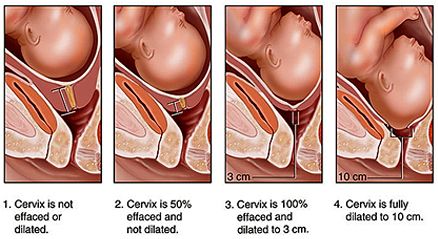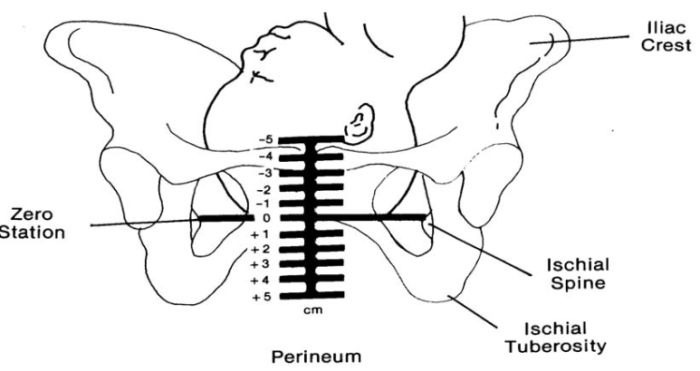Definition of "Bishop score"
Bishop score (aka cervix score, cervical favorability) is a pre-labor scoring system. Cx is shorthand for cervix.
Patient information
What's the Bishop score?It's a way that we score how ready bub is ready to come out. We find that from a vaginal exam.
How do we know that?
We surmise this from where the cervix is found. How stretched the cervical hole is. How thin the cervix is, as caused by stretch of the descending baby. It's softness. And how low the fetal head has come down.
- Predict whether IOL will be required, based on whether a spontaneous birth will occur [without the need of IOL]
- Assess the odds labor will commence spontaneously
Patient information
Why woud you want to know how ready bub is to come out?If it's taking too long, you might want to induce labor. That's because we don't want labor to be "prolonged". So if that's not going to happen spontaneously, we're going to have to induce.
When do you consider labor to be prolonged?
Prolonged labor is when the total duration of childbirth is >24 hours. Or the latent phase >8 hours. Or when the active phase is >12 hours.
Wait... how do you know this until AFTER the event has happened? That'd be too late already? And why would you need a vaginal exam for this?
You wouldn't. And that's why we look at progress. We want cervical dilation of at least 1cm per hour. And that's why we repeat the vaginal exam over time.
Going back to the Bishop score then. What use is a single score? What can it tell us?
Likelihood of spontaneous labor. The more stretched the cervix. The more softer. The lower the baby's head. The more likely spontaneous labor will happen.
The score is assessed based on 5 components of vaginal examination, including (which can be memorized with the mnemonic PEDSS):
- Cervical position (3), which varies between women. As the anatomical location of the vagina is actually downward facing, anterior and posterior relatively describe the upper and lower borders of the vagina. The anterior position is better aligned with the uterus, so there is an increased likelihood of spontaneous delivery
- Cervical effacement (3) (aka cervical ripening), which is a measure of stretch/thinning present in the cervix, which can be expressed as a percentage. It is analogous to a stretched rubber band, which as stretched further, becomes thinner. This depends on individual variation, and previous surgery (e.g. loop excision). The cervix begins like a long bottleneck, about 4cm in length. Throughout pregnancy, the cervix is tightly closed and protected by a plug of mucus. When the cervix effaces, the mucus plug is loosened and passes out of the vagina. The mucus may be tinged with blood, and the passage of the mucus plug is called a bloody show. As effacement occurs, the cervix then shortens (effaces), pulling up into the uterus and becoming part of the lower uterine wall. Effacement can be measured in percentages, from 0% (not effaced at all) to 100% (paper thin cervix)
- Cervical dilation (3), which is a measure of the diameter of the stretched cervix. It complements effacement, and is the most important indicator of progressor through the 1st stage of labor. The opening of the cervix (i.e. entrance to the uterus) can occur [generally] due to childbirth, miscarriage, induced abortion, or gynecological surgery
- Latent phase (0-3cm): In the later stages of pregnancy, the cervix may already open up to 1-3cm [or even more, but rarely]
- Active labor (4-7cm): During labor, repeated uterine contractions leads to further widening of the cervix to about 6cm
- Transition (8-10cm): Pressure from the presenting part (head in vertex births, or bottom in breech births), along with uterine contractions will cause further dilitation to 10cm, which is "complete"

Source: Blogspot
| |
    |
- Cervical softness/consistency (3), which is primigravid women, the cervix is tyipcally tougher/resistant to stretching, akin to a balloon that hasn't been previously inflated. For subsequent vaginal deliveries, the cervix becomes less rigid, allowing for easier dilitation at term. In young women, the cervix is also more resilient than in older women
- Fetal station (3), which describes the position of the fetus' head in relation to the distance from the ischial spines, which can be palpated deep inside the posterior vagina (approximately 8-10cm) as a bony protrusion. It is measured from -5 (floating), 0 (fully engaged), to +5 (crowning). The "zero" is at the ischial spines, with negative numbers indicating above, and positive numbes indicating below. Full engagement (@ 0) is notable because the widest diameter of the head has passed below the pelvic inlet. Crowning (@ +5) is notable because the fetal head appears at the vaginal orifice

Source: Sweet haven
Patient information
Cervical dilation and effacement, are they related? It's a little hard to understand all these numbers ...!!!
...!!!Think of it like playdough being smashed from above, from something tower-shaped, to something flat. The cervical dilation is the horizontal measure, so that increases. The effacement is the vertical measure, so that decreases. When that happens, we don't say that it increases however - we say that effacement increases, because it becomes "more thinner", which is a step forward rather than a step back!
Why can you measure effacement as a number or percentage?
You can either measure the vertical length, which should decrease. Or express it as a percentage. Some people prefer the percentage, because it seems like it's "progressing" from 0 to 100%. Whereas when the number decreases - and it does because it gets "shorter"... it seems like things are going backwards 
The highest score is 13, with scores:
- >8, indicates labor will most likely commence spontaneously
- <6, suggests labor is unlikely to start without induction → indicates IOL
Find a practitioner
Practitioner count: 0